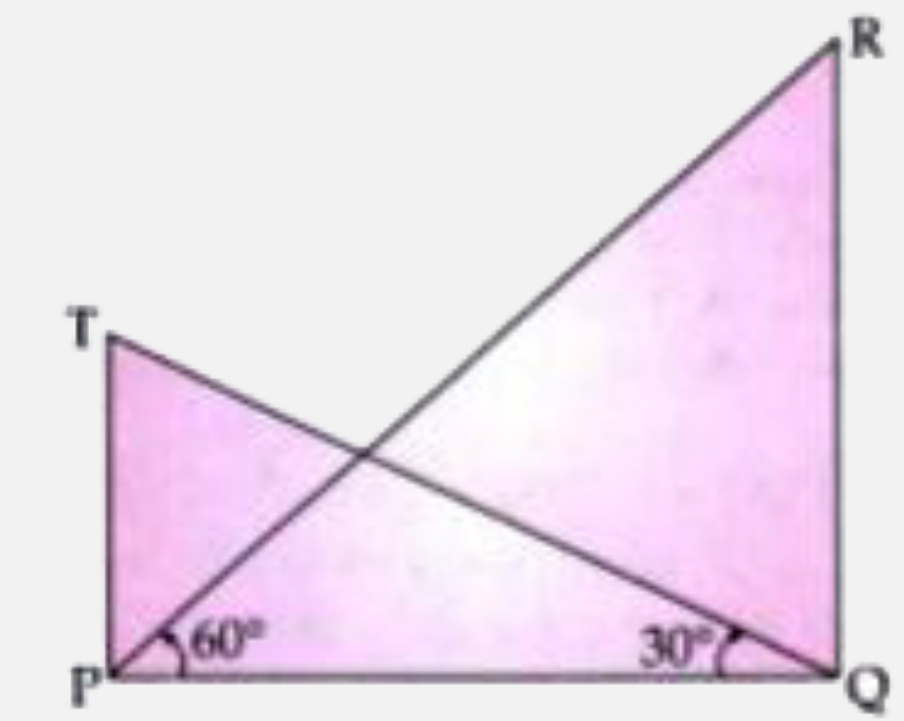The angle of elevation of a tower PQ at a point A due north of it is 30∘ and at another point B due east of A is 18∘. If AB =a. Then the height of the tower is
a(2+√5)
a(2−√5)
a√2+2√5
None of these
The correct Answer is:C
To solve the problem step by step, we will follow the geometric relationships and trigonometric ratios involved in the angles of elevation.
Step 1: Draw the Diagram
Draw a vertical tower PQ and mark point A due north of the tower and point B due east of A. Label the height of the tower as h.
Step 2: Identify the Angles
From point A, the angle of elevation to the top of the tower (point P) is 30∘. From point B, the angle of elevation to point P is 18∘.
Step 3: Set Up the Right Triangle from Point A
In triangle PAQ (where Q is the base of the tower), we can use the tangent function:
tan(30∘)=hAQ
From trigonometric values, we know:
tan(30∘)=1√3
Thus, we can write:
1√3=hAQ⟹AQ=h√3
Step 4: Set Up the Right Triangle from Point B
In triangle PBQ, we can again use the tangent function:
tan(18∘)=hBQ
Using the known value of tan(18∘):
tan(18∘)=√5−12
Thus, we can write:
√5−12=hBQ⟹BQ=2h√5−1
Step 5: Relate the Distances
Since point B is due east of point A, we can express AB as:
AB=AQ+BQ
Substituting the values we found:
AB=h√3+2h√5−1
Step 6: Use Pythagoras Theorem
Using the Pythagorean theorem in triangle ABQ:
BQ2=AB2+AQ2
Substituting the values:
(2h√5−1)2=a2+(h√3)2
Expanding both sides:
4h2(√5−1)2=a2+3h2
Step 7: Solve for h2
Rearranging gives:
4h2(√5−1)2−3h2=a2
Factoring out h2:
h2(4(√5−1)2−3)=a2
Thus,
h2=a24(√5−1)2−3
Step 8: Final Expression for h
Taking the square root gives:
h=a√4(√5−1)2−3
Conclusion
The height of the tower h can be expressed as:
h=a√2+2√5
Draw a vertical tower PQ and mark point A due north of the tower and point B due east of A. Label the height of the tower as h.
From point A, the angle of elevation to the top of the tower (point P) is 30∘. From point B, the angle of elevation to point P is 18∘.
In triangle PAQ (where Q is the base of the tower), we can use the tangent function:
tan(30∘)=hAQ
From trigonometric values, we know:
tan(30∘)=1√3
Thus, we can write:
1√3=hAQ⟹AQ=h√3
In triangle PBQ, we can again use the tangent function:
tan(18∘)=hBQ
Using the known value of tan(18∘):
tan(18∘)=√5−12
Thus, we can write:
√5−12=hBQ⟹BQ=2h√5−1
Since point B is due east of point A, we can express AB as:
AB=AQ+BQ
Substituting the values we found:
AB=h√3+2h√5−1
Using the Pythagorean theorem in triangle ABQ:
BQ2=AB2+AQ2
Substituting the values:
(2h√5−1)2=a2+(h√3)2
Expanding both sides:
4h2(√5−1)2=a2+3h2
Rearranging gives:
4h2(√5−1)2−3h2=a2
Factoring out h2:
h2(4(√5−1)2−3)=a2
Thus,
h2=a24(√5−1)2−3
Taking the square root gives:
h=a√4(√5−1)2−3
The height of the tower h can be expressed as:
h=a√2+2√5
Similar Questions
The angular elevation of a tower OP at a point A due south of it is 60∘ and at a point B due west of A, the elevation is 30∘. If AB=3m, the height of the tower is
View SolutionThe angle of elevation of the top of a tower a point A due south of it is 30∘ and from a point B due west of it is 45∘ .If the height of the tower is 100 meters ,then find the distance AB.
View Solution
Knowledge Check
The angular elevations of a tower CD at a place A due south of it is 60∘ , and at a place B due west of A, the elevation is 30∘ . If AB=300m, what is the height, in meters, of the tower?
A30B30√6C30√10D30√30
The angle of elevation of the top of a tower from a pointA due south of the tower is α and from B due east of tower is β. If AB=d, show that the height of the tower is d√cot2α+cot2β.
View SolutionThe angle of elevation of the top of a tower from a pointA due south of the tower is α and from B due east of tower is β. If AB=d, show that the height of the tower is d√cot2α+cot2β.
View SolutionThe elevation of a tower at a station A due north of it is α and at a station B due west of A is β. Prove that the height of the tower is ABsinαsinβ√sin2α−sin2β
View SolutionThe elevation of a tower at a station A due North of it is α and at a station B due West of A is β . Prove that height of the tower is ABsinαsinβsin2α−sin2β .
View SolutionThe angle of elevation of the top of a vertical tower from a point A due east of it is 45∘. The angle of elevation of the top of the same tower from a point B due south of A is 30∘. If the distance between A and B is 54√2 m then the height of the tower (in metres), is
View SolutionProblem on sine rule Type:-2 (i)The angle of elevation of the top of the tower from a point A due South of the tower is α and from B due east of the tower is β. If AB=d Show that the height of the tower is d√cot2α+cot2β (ii) A tree stands vertically on a hill side which makes an angle of 15∘ with the horizontal. From a point on the ground 35m down the hill from the base of the tree ; the angle of elevation of the top of the tree is 60∘ .find the height of the tree ?
View SolutionThe angle of elevation from a point pof the top of a tower QR, 50m high is 60∘ and that of ther tower PT from a point Q is 30∘. Find the height of the tower PT, correct to the nearest metre.

View Solution
